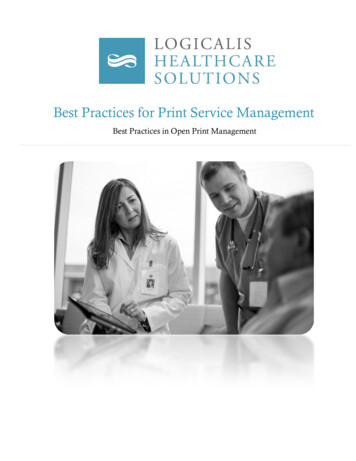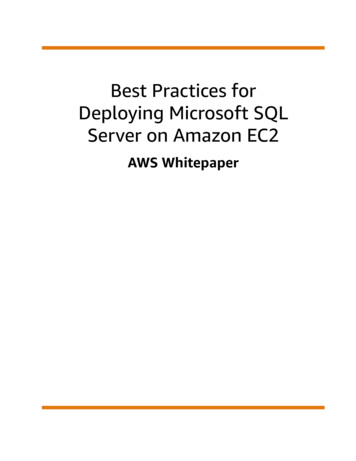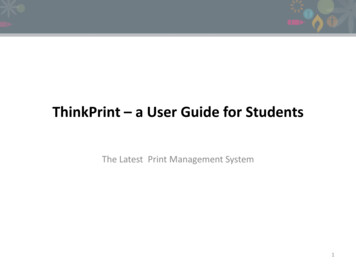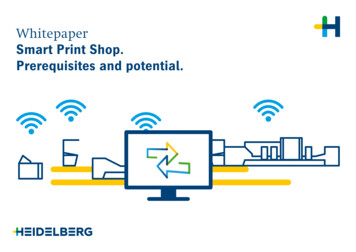
Transcription
Best Practices for Print Service ManagementBest Practices in Open Print Management
Best Practices for Print Service ManagementPlan Design Measure Analyze Improve Control1. Develop and maintain a print strategy:For businesses that wish to reduce costs by managing their printing, a document andprint strategy is essential. Best practices conclude that fleet assessment and strategydevelopment should be hardware manufacturer independent. Independence shoulddeliver a high degree of objectivity. Without this independence, the risk is that theassessment will be focused on hardware technology, not business needs.An advanced Print Strategy should be policy driven with the flexibility to encompassnew policies quickly and efficiently to enable a high degree of business agility. Itshould include a cl ear definition of the infrastructure tools to support theimplementation and management of the strategy, current and future functionalrequirements, design principles and policies, device retirement policies, service policiescovering device and user service availability, baseline print costs, their drivers and costtargets, implementation recommendations which consider the rate of change yourbusiness can realistically manage, a solution scalable corporate-wide not just focused onproof of concept pilot sites, and methods for measuring results of post implementation.A proposal from a supplier for more services and/or hardware does not constitute astrategy. Your strategy and infrastructure tools should be independent from the hardwarevendor to ensure you have an objective view for both the short medium and long term.Relying on the manufacturer to decide which device is most cost effective for yourcorporation carries the risk that the hardware vendor, who is motivated to sell moredevices and associated consumables, ink and toner, will recommend just that. Thecorporate print strategy should be revisited every 3 to 5 years and should includeproper benchmarking.2. Establish a service baseline:The baseline assessment is used as the starting point for developing the corporateprint strategy. During baseline assessment, best practices must incorporate all costsinto the picture, not just consumables - the largest cost being human resources andtheir efficiency in using the service. The service baseline should consider device andprinting behavior over a period of time, 30 to 60 days, and include how the service isdelivered, what impacts it is having on business cost and productivity, the functionalneeds of the business, how much printing is being produced, and precisely what is beingpurchased at what cost.
Note: If the current Print Service Provider already has a printer fleet management toolthat contains a database of device inventory, printing activity and printer events, hisrevenue could be increased by offering professional independent assessment services.In addition, the service provider should be able to prepare a competitive managed printservices proposal based upon the current inventory and understanding of his client’sprinting history. A greater knowledge of the printer fleet than both their client andcompetitor is a significant strategic advantage. Many organizations now require anindependent assessment to ensure greater objectivity and transparency to actual fleetperformance.3. Treat printing equipment as an IT asset:Best practices recognize that the Printer Fleet is a corporate asset, and thereforeshould be managed as any other IT asset. Printer asset management should look atthe fleet from the enterprise perspective analyzing each device through its lifecyclehistory. A printer lifecycle encompasses purchase decisions, upgrades, printerfinancials, maintenance, supplies management, moves and retirement. The enterpriseperspective looks at the fleet using corporate metrics, comparisons and trends, makingdecisions from a global, rather than, unit, user or commodity basis.Most suppliers look at a snapshot in time to track, optimize & identify cost savings. To dothis, approximations for costs are used which are often highly inaccurate. Your printstrategy infrastructure software suite should address inventory cost, location and itschanges through time, including maintenance, supplies usage and support multi-vendorequipment. The information should allow you to decide when to retire printers and whichmodel/manufacturer is most cost effective as a replacement.4. Optimize:Best practice focuses on optimizing the number of hardware manufacturers, the numberof different device models, and the number of suppliers & service providers, according toyour company’s functional needs. In some cases this will result in reducing the numbero f devices but not necessarily so. The objective is to increase user productivity anddevice reliability throughput and yields and to reduce inventory and intervention costsdue to assets, toner supplies, supplies replenishments and failures.The general direction of managed print services is to reduce total costs, to reduce theamount of printing, to reduce the number of devices, to reduce the number ofmanufacturers and models, and to reduce the number of suppliers. However if thesereductions drive up interventions due to device over use causing lower device reliability,reprints and waste from contention, productivity will be lost and user satisfaction willsuffer.
5. Automate:Managing print services in a cost effective manner requires automation of many of theprocesses involved. Automatic device discovery and meter reads are only thebeginning. The printer fleet management tool should also automate assetmanagement, location management, cost management, availability management,service requests in the event of a device alert (having intelligently eliminated irrelevantinformation and warnings at a device and fleet level) toner requests grouped to minimizetransaction and shipping costs, scheduled maintenance requirements, deviceretirement and replacement scheduling, scheduled reports, printer supplies yield withcomparisons, amongst others. The managed services should not add to the humanresource burden rather relieve it to deliver an optimized service.6. Manage Desktop Printers:Desktop directly connected printers can often be the most expensive component of theprinter fleet on a per page basis. Not only do they tend to be underutilized, supplies areexpensive and the printers are complex to track and manage. Best practices recommendeliminating printing using direct attached printers except where absolutely necessary.The typical reasons for eliminating these devices are as follows: The highest per page printing cost (TCO) Complex supplies management Greater supplies inventory costs Increased software management complexity Added complexity for asset management Regulatory and policy compliance issues.Unfortunately, in some organizations there can be a proliferation of direct attachedprinters, resulting in challenges to manage these costs effectively. Lifecycle costs canmean it is actually much more cost effective to provide low cost network alternatives todirect connected devices even if the company strategy for good reasons allows certainemployees to keep personal printers.Where necessary, best practices recommend that the printers be restricted to a limitednumber of hardware model choices and should be network-attached, not USB-attached,to make them consistently visible to the network and to the management tools.
7. Governance for suppliers:Best practices require that suppliers be actively managed. This includes all suppliers:hardware, software, service, supplies, and consulting. Your suppliers’ objectives may notnecessarily be compatible with your corporate objectives. Some corporations hireindependent consultants during the assessment and strategy phase, but the deployment,and operational phase also requires quality control and supplier governance.Service Level Agreements (SLA), specify contractual activities that ensure your printersare available for use. The only way to ensure that the service supplier adheres to theSLA is to monitor the critical items over time. These metrics include % uptimes both fordevices and the overall service delivered, average time it takes to resolve any issues, andfrequency of breakdown. Other areas of vendor governance include billing accuracyand corporate resources expended for the supplier.8. Sustain savings through ContinuousImprovement:Once the fleet strategy is deployed, the corporation optimizes enterprise printing throughpro-active monitoring of printer assets, failures and interventions, supplies management,and s e r v i c e l e v e l a g r e e m e n t s. Infrastructure management software, which collectsand stores device and printing data with history and the ability to produce meaningfulmanagement information, is critical.Continuous improvement requires active and ongoing attention to print assets andfunctional business needs. Human behavior can easily slip back into old habits. Activemonitoring and management automation can alleviate increases in costs arising fromhuman frailties. It is a fallacy to rely upon the manufacturers’ benchmarks for eachmodel since they are unlikely to reflect your business and management policies. Eachorganization has different printing behaviors and needs, it is this you need to manageand control.9. Monitor, Measure, Manage:The key to sustaining the savings from managing printing is to measure, adjust,measure, and adjust on a continuous and ongoing basis. This is where Managed PrintService Providers can retain and increase business by proactively demonstrating theirvalue with regular reports on their customer’s printing which should include trend analysisshowing pages, costs, interventions, availability and problems. This report should identifybusiness changes and areas where improvements can be made such as moving,swapping, or replacing equipment always with a view to reduce total printing costs,interventions and increasing user service availability.
As mentioned above, a print infrastructure management suite, is required to continuouslymonitor the corporate print environment to manage and generate the information foradvanced business reports.10. Regular reporting and benchmarking:Inherent in managed print services is a regular re-assessment of the corporate printenvironment. As with any business best practice, scheduled comparative assessments orbenchmarks are necessary to stay on track competitively and strategically. The primaryobjective is to ensure that the savings realized by managed print services are beingmaintained. For instance, your strategy may have a target of 1 failure and 5 tonerinterventions per device per year. However without due diligence and constant attention,this target may well deviate with cost and productivity implications. Regular comparativeanalysis would highlight any deviation from targets and policies. In addition technology isconstantly changing so the policies established at the start of the contract may no longer beappropriate to deliver the service you require. Reporting according to a schedule istherefore critical.Our recommendation is to conduct formal service reviews with a report of the corporateprinting environment every 6 months to reveal trends against policies but without creatinga management overhead. Monthly reports should be available allowing significantissues to be dealt with outside of formal reviews.Formal benchmarking should be conducted every 2 to 3 years prior to contract renewaland should include user satisfaction analysis and productivity impact assessments. Toensure a cost effective approach, a print management infrastructure suite thatcontinuously monitors printer service volumes and printing activities should perform thisreporting.The more you know about your fleet, the greater thepotential for cost savings. Adopting these bestpractices on an ongoing basis will surely pay off andbe reflected on your financial statements.
As mentioned above, a print infrastructure management suite, is required to continuously monitor the corporate print environment to manage and generate the information for advanced business reports. 10. Regular reporting and benchmarking: Inherent in managed print services is a regular re-assessment of the corporate print environment.










